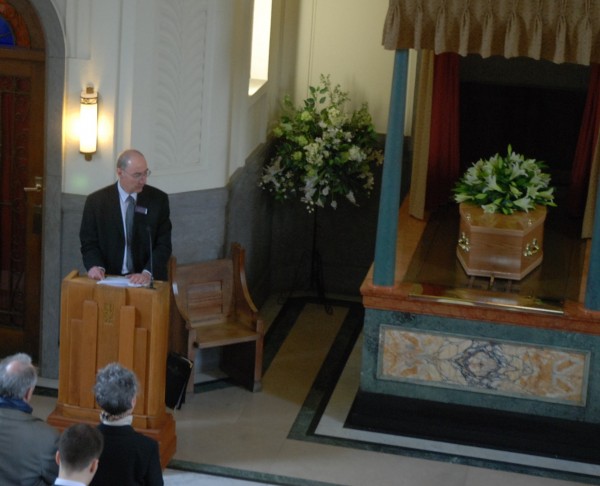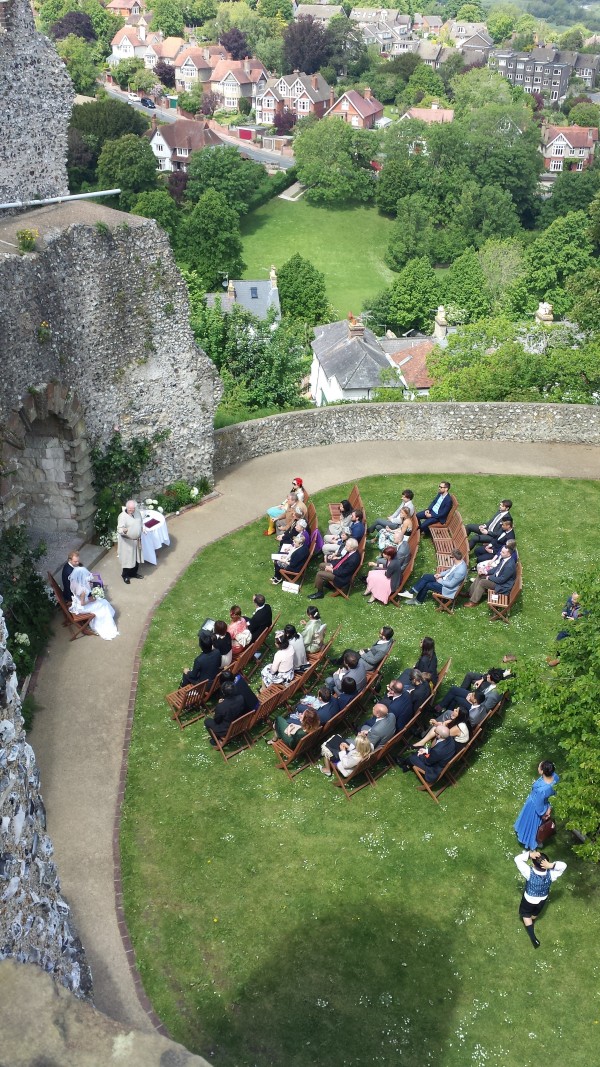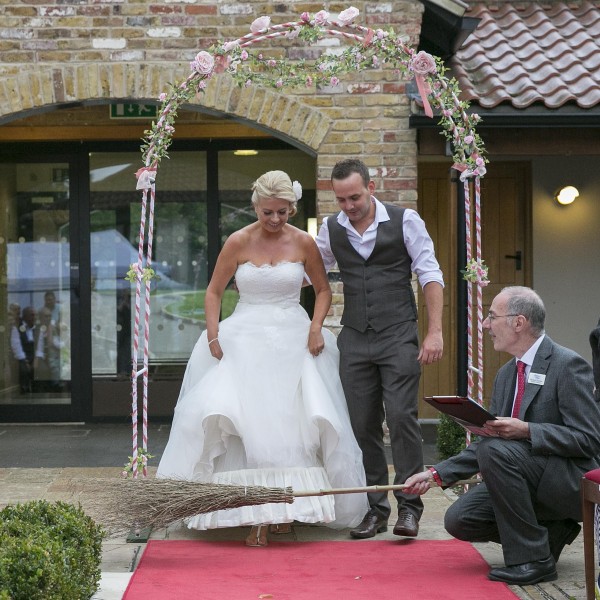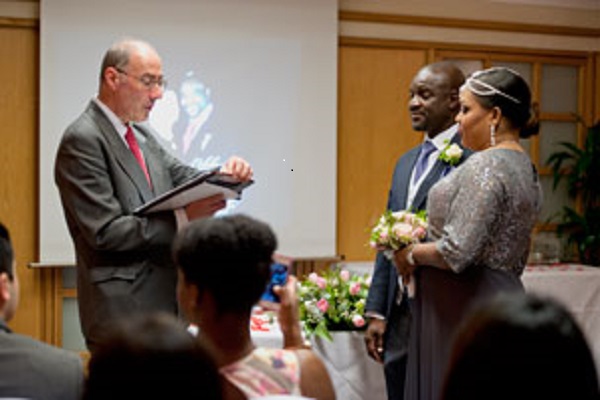by Michael | Jul 12, 2016 | Blog
If you had the choice to go out with your wife to a pub quiz or to attend a Death Cafe, which would be the more appealing?
Well, obviously (or there’d be little point in this article!), I opted for the Death Cafe. I didn’t really know what to expect, except that the agenda was to talk about death and also consume some cake and coffee.
Arrival
So I showed up at the West Hampstead cafe at the appointed hour, to a warm welcome from the twin organisers. We were to comprise a baker’s dozen – apparently a small number compared to more-established cafes. However, there was also a film crew, which I had not anticipated!
Slightly unbelievably, they had found us from Quebec. They were filming an international documentary for TV5 (I think) on life transitions. There are apparently some 3,000 Death cafes across the world, since Jon Underwood started the whole thing off in 2010, and they had chosen us!
People were free to opt out of the filming, and the crew was extremely discreet and professional. Initially, the idea of talking to strangers about death might have been a wee bit inhibiting, even without cameras and microphones in the vicinity, but we soon accepted it.
What actually went on?
The evening was divided into two parts after sustenance had been ordered. (The meeting was free, as this is a non-profit-making organisation, but we were encouraged to spend at least £8 a head to recompense the cafe-owner for staying open exclusively for us.)
First, we sat in small groups, with a facilitator at each table. Nothing was prescribed. We started by introducing ourselves (in the knowledge that all our conversations were confidential). We explained why we had turned up that evening. A number already had had experience of other Death Cafes, but quite a few were newbies like me.
One explained how she had very recently lost a friend, and had had no opportunity to discuss her feelings. Another was a psychotherapist, who was working more with older people, and was interested in seeing what was on offer here. I had come out of curiosity, and to see if, with my funeral experience as a civil celebrant, I might be of any help to others.
The conversation – often punctuated with laughter – meandered around various subjects, and the facilitator did not have to work hard to support us. Everyone was respectful and prepared to listen, and an hour soon passed.
After a break, we reconvened in one big circle. Most of those present were probably in their sixties or thereabouts, and the vast majority were female. We mentioned themes we had discussed separately in groups, and developed them. There were a few silences this time, but the conversation grew apace, and this hour also went very quickly.
What is the point of a Death Cafe?
According to the website, www.deathcafe.com, the objective is ‘to increase awareness of death with a view to helping people make the most of their (finite) lives’. The meeting is a discussion group, rather than grief support or counseling session.
Would I go again?
It was good talking freely about a taboo subject, and I think it was a very useful – as well as enjoyable – exercise, and one I would be prepared to repeat. Every meeting is different, not least because the mix of people is different.
Whether I would have had such a worthwhile evening at the pub quiz is quite a moot point!

by Michael | May 23, 2016 | Blog
The best that can usually be said about a death is that “it was a release” or “X had a wonderful death”. (One example of the latter in my experience was a nonagenarian who died on the beach in Tenerife by the side of his girl-friend!)
Be that as it may, a funeral is normally a time when you expect the family and friends to rally round. Mind you, as a civil celebrant, I’ve known some exceptions.
In one case, one sister decided not to forward my draft funeral to her brother (so that he would have no input)! In another instance, one brother simply vetoed whatever his siblings proposed. (We only got that funeral approved the afternoon before the ceremony!) And one son never even showed up to his mother’s funeral (as he had seen the will and knew he would be inheriting …!)
However, in the vast majority of cases, there is a sympathetic coming-together of folk. Sometimes people come from a very long way to show solidarity.
If it’s not to be a set religious ceremony, the closest kin of the deceased are normally invited to contribute to the planning of the service. The civil celebrant can explain what is required and offer guidance, especially as the family member(s) may be feeling very vulnerable and confused (although there is a wide range of emotions they may be experiencing).
A lot of people find discussing the eulogy surprisingly enjoyable. It’s certainly an outlet for releasing a few feelings, and not everything that is mentioned needs to be included in the final reckoning. However, trawling up those stories and memories can be very therapeutic.
The service itself is likely to be a difficult time for many people (and shows of emotion – or lack of it – can often take people by surprise). However, there is usually comfort to be found from being surrounded by sympathetic relatives and friends.
![DSCF0126[2]](https://vowsthatwow.co.uk/wp-content/uploads/2016/01/DSCF01262.jpg)
A reception (or even a wake) is common, and that can take various forms. It may just be some sandwiches and drinks (whether alcoholic or otherwise); however, there may be mementos of the deceased (often photo albums and the like). The deceased will be a good starting-point for conversation (so everybody has one thing in common, at least). Once the channels of communication are open, the reception can turn into a genuine social event.
Circumstances dictate that some deaths are far harder to accept than others, but those who attend a funeral often find that the whole occasion has been cathartic – and , in a way, even enjoyable.
So, much good frequently comes from what is a sad rite of passage.
by Michael | May 17, 2016 | Blog
I have to confess that April was a very quiet month for me. For whatever reason, I had to scratch around for celebrant work, and found myself twiddling my thumbs some of the time. Was I condemned to the simple life?
Mercifully, a switch was flipped this month. But iI didn’t just get a wedding and a funeral for one week, and a Vow Renewal and another funeral, say, for the next. No it all came at once!
Following a (long-planned) wedding last weekend, I had to conduct a funeral on Monday, and was given three days’ notice for another one (which isn’t long, believe me!).
At the same time, a couple from South Africa, coming to London in three weeks, were trying to arrange a Vow Renewal (to surprise the husband). Would I locate a venue urgently, please?
Now I’m turning into an Event Planner!
Just before all that, a Paris travel agent phoned me out of the “bleu” and asked me if I could lead a Vow Renewal for a couple from Quebec – next week! Despite the lack of time available to prepare, I agreed. But it didn’t turn out to be straightforward.
Somewhere between myself, the travel agent, his colleagues in Quebec and the end client, the wrong contact details were passed. I had no way of getting through directly to the client (especially at the weekend), and it was only when he and his wife arrived in London (on Monday evening) that we made contact.
So I had to work very fast to compile a ceremony of choice.
One reason why the client had not been keen to contact me directly was because he was ashamed of his spoken English!
It also turned out that the husband was planning to surprise his wife too, so I was only able to communicate with him by text. Eventually, we were ready (so I thought) for Wednesday’s ceremony.
On the day, he texted me: could I find a photographer for the ceremony? (Event Planner again!) Fortunately, I have quite a wide data-base of suppliers, and I was able to find a suitable professional who chanced to be free that afternoon.
One further complication was that, although the husband had said that his wife was bilingual and that he understood English well enough, it was clear during the ceremony that he was struggling with his English.
I felt I had no option but to try and translate the important bits into French as we went. Now I had to be a simultaneous translator!
So, all in all, a very interesting, exciting 10 days for me. Everything turned out well, thank goodness, and I’d love to do more of the same, in truth, despite the pressure.
I’ve seen how far I can be pushed and still emerge unscathed, that I can adapt and work well under pressure, and I’m very proud. However, there is also something to be said for the simple life!

by Michael | May 10, 2016 | Blog
Celebrating a big event? A wedding, vow renewal or naming ceremony, perhaps? Did you realise that it doesn’t have to be conventional? Or even religious?
But can it be a quirky ceremony?
The answer to that last question is a resounding “yes”! If it’s your day (and surely it is), then you don’t have to be beholden to what other people think or expect.
That certainly doesn’t mean you should be tasteless or offensive – but you can be different. There is huge scope for creativity. It doesn’t take so much effort to come up with a memorable, meaningful and beautiful ceremony. And for all the help you will need, a civil celebrant can be there, with ideas and guidance. They are professionals and can really point you in the right direction.
So what do we mean by “quirky”?
The venue can be anywhere (subject to permission and possible payment!). Why not hold a ceremony at Stonehenge or some other ancient monument? What about the top of the Shard in London? Or perhaps a hot-air balloon fits the bill? A museum? Your back garden? Let your imagination soar!

Rituals
Part of the ceremony can be something a little offbeat. You’ve probably read about handfastings in my blogs (eg https://vowsthatwow.co.uk/handfasting-whats-that/). That might appeal.
A ritual that brings a smile to a wedding is “Jumping the Broom”. The couple together jump over a besom (accompanied by appropriate words) to symbolise sweeping in the new.
The Unity Sand option is lovely. Both partners simultaneously pour sand in the colour of their individual choice into one larger bottle, so that the colours merge, just as their lives will.
Readings & Music
The content of the ceremony is ‘up for grabs’ too. The tone is up to you. There is no compulsion to include heavy, serious readings, if you don’t want them. Why not have a humorous poem or text, or even a few?
Choose your readers, if you want.
Similarly, while there’s absolutely nothing wrong with having a serious, classical piece played, your tastes may actually be rather different. So by all means let the music reflect these.
Your story, your vows
Personally, I welcome the opportunity to make ceremonies that I conduct as personal as possible. I believe the guests enjoy and appreciate this a lot too.
One feature I like to include, therefore, is what I call the couple’s “story”. In the case of a wedding, it might be how they met, adversity they had to overcome, and what attracted them to each other. The couple might write and declare their vows. For a Vow Renewal, maybe the couple would rewrite their vows, or prepare something about key moments in their relationship.
Although I’m always there to guide and advise, I think it’s best if the couple actually write this part themselves, if possible.
Funerals
It may surprise some readers to know that a funeral can be a quirky ceremony too!
In the same way as for celebratory occasions, you can introduce personal elements (often these would be personal to the deceased). At the time of writing, my latest funeral ended with everybody smiling and swaying, as we played out with the deceased’s favourite trad jazz band tune!
There are many ways to individualise a funeral. It can be a simple thing like a particular memento of the deceased displayed by the coffin. Again, your funeral celebrant will be glad to advise.
So I hope you now see that there’s nothing wrong with individualising your ceremonies – indeed, this can often add a tremendous amount to the proceedings.

by Michael | Feb 3, 2016 | Blog
As a civil celebrant, I am sometimes asked by potential clients for sample ceremonies. What sort of prayers and readings might I suggest?
That’s a sort of “how long is a piece of string?” question, because I only offer my clients ideas and guidance – I don’t dictate. Each ceremony is therefore different from any other I conduct. Indeed, I have an in-depth conversation before I even start putting the metaphorical pen to paper.
Some ceremonies may be religious, others spiritual, or purely secular. So there’s absolutely no “typical” reading.
However, what I will therefore offer now is a couple of readings that I have used in the past, and they will give you some sort of an idea of what could go into a ceremony.
This time, I’ll look at weddings and handfastings; another time, vow renewals and funerals.
Weddings
The Welcome
Love is a miraculous gift, and a wedding is a celebration of that gift. We have come here today to celebrate this gift of love, and to add our best wishes and blessings to the words that shall unite AB and CD in the bonds of marriage.
What you promise to each other today must be renewed again tomorrow and every day that follows.
At the end of this ceremony, you will be husband and wife. Still, you must decide each and every day to commit yourselves to one another. Make such a decision, and keep on making it, for the most important thing in life is to love and to be loved.
Reading
Listen to these words of wisdom on how to create a successful marriage from a little book entitled The Art of Marriage.
The little things are the big things.
It is never being too old to hold hands.
It is remembering to say I love you at least once a day.
It is never going to sleep angry.
It is at no time taking the other for granted;
the courtship should not end with the honeymoon, It should continue through all the years.
It is having a mutual sense of values and common objectives; it is facing the world together.
It is forming a circle of love that gathers in the whole family.
It is doing things for each other, not in the attitude of duty or sacrifice, but in the spirit of joy.
It is speaking words of appreciation and demonstrating gratitude in thoughtful ways.
It is not expecting the husband to wear a halo or the wife to have the wings of an angel.
It is not looking for perfection in each other.
It is cultivating patience, understanding, and a sense of humour.
It is having the capacity to forgive and forget.
It is giving each other an atmosphere in which each can grow.
It is finding room for the things of the spirit.
It is the common search for the good and the beautiful.
It is the establishing of a relationship in which the independence is equal, the dependence is mutual, and the obligation is reciprocal.
And finally, it is not only marrying the right partner, it is being the right partner.
Apache Blessing
Now you will feel no rain, for each of you will be a shelter for the other. Now you will feel no cold, for each of you will be warmth to the other. Now there will be no loneliness, for each of you will be a companion to the other. Now you are two persons, but there is only one life before you. Go now to your dwelling place to enter the days of your togetherness. May beauty surround you both in the journey ahead and through all the years. May happiness be your companion, and may your days together be good and long upon the earth.
Don’t you just love this blessing?!
Handfasting
The actual handfasting
The lover’s knot, or knot of destiny, will now be tied by Divine Power in the name of Love. (Celebrant ties hands). With this cord, I bind you to the vows that you each have made. As your hands are bound together now, so your lives and spirits are joined in a union of joy, love, trust, and mutual support. This bond I draw between you: That though you are parted in mind or in body, there will be a call in the core of you, one to the other, to which no one else will answer. By the secrets of earth and water this bond woven–unbreakable, irrevocable; by the law that created fire and wind this call is set in you, in life and beyond life.
A., repeat after me…By seed and root…by bud and stem…by leaf and flower and fruit…by life and love…in the name of God…I, A., take thee, B., to my hand, my heart and my spirit.
B., repeat after me… By seed and root…by bud and stem…by leaf and flower and fruit…by life and love…in the name of God…I, B., take thee, A., to my hand, my heart and my spirit.
Celebrant: With this binding I tie you, heart to heart, together as one. B. & A., together repeat after me…Heart to thee…soul to thee…body to thee…forever and always…and so it is! With this knot you are joined in sacred union. May God smile upon you, and bless you with love, happiness, peace, health, and prosperity.
Perhaps this will give you a flavour of what our ceremony might be like. If you’d like a chat and want to find out more, please give me a call (07931 538487), without obligation. I look forward to hearing from you.


![DSCF0126[2]](https://vowsthatwow.co.uk/wp-content/uploads/2016/01/DSCF01262.jpg)


